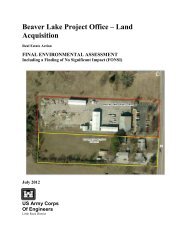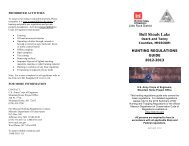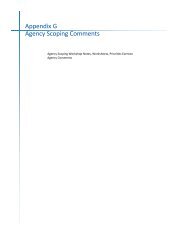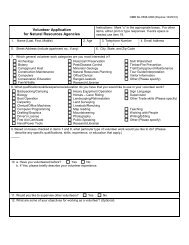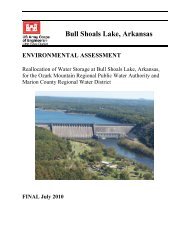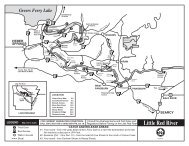Arkansas River, Fort Smith, AR, May Branch Flood Reduction Project
Arkansas River, Fort Smith, AR, May Branch Flood Reduction Project
Arkansas River, Fort Smith, AR, May Branch Flood Reduction Project
Create successful ePaper yourself
Turn your PDF publications into a flip-book with our unique Google optimized e-Paper software.
DEP<strong>AR</strong>TMENT OF THE <strong>AR</strong>MY<br />
US <strong>AR</strong>MY ENGINEER DIVISION, SOUTHWESTERN<br />
1100 COMMERCE STREET, SUITE 831<br />
DALLAS TX 75242-1317<br />
REPLY TO<br />
ATTENTION OF<br />
CESWD-PDS-P (1105)<br />
MEMORANDUM FOR Commander, Little Rock District<br />
SUBJECT: Review Plan for <strong>May</strong> <strong>Branch</strong>, <strong>Fort</strong> <strong>Smith</strong>, <strong>Arkansas</strong> Preconstruction Engineering and<br />
Design<br />
1. References:<br />
a. EC 1105-2-410, 22 August 2008, Review of Decision Documents.<br />
b. Memorandum, CECW-CP, 30 March 2007, subject: Peer Review Process.<br />
c. Addendum to Reference l.b., CECW-CP, September 2008, subject: Supplemental<br />
Information for the Peer Review Process.<br />
2. The review plan for the subject study, enclosed, has been reviewed and cleared for approval<br />
by the <strong>Flood</strong> Risk Management Planning Center of Expertise. It has been prepared in<br />
accordance with the referenced guidance, and public comments received will be incorporated<br />
into the plan as the study progresses. It is anticipated to require Type II Independent External<br />
Peer Review (Safety Assurance Review).<br />
3. I hereby approve this review plan, which is subject to change as study circumstances require,<br />
consistent with study development under the <strong>Project</strong> Management Business Process. Subsequent<br />
substantial revisions to this plan or its execution will require new written approval from this<br />
office.<br />
4. If you have questions or need further information, please contact JoAnn M. Duman,<br />
CESWD-PDS-P, at (469) 487-7065.<br />
Encl<br />
;jL~<br />
rfl ANTHONY C. FUNKHOUSER<br />
Colonel, EN<br />
Commanding<br />
CF:<br />
CESWL-PE (Smethurst)
REVIEW PLAN<br />
<strong>May</strong> <strong>Branch</strong>, <strong>Fort</strong> <strong>Smith</strong>, <strong>Arkansas</strong><br />
Preconstruction Engineering and Design<br />
Little Rock District<br />
12 November 2009
REVIEW PLAN<br />
<strong>May</strong> <strong>Branch</strong>, <strong>Fort</strong> <strong>Smith</strong>, <strong>Arkansas</strong><br />
Preconstruction Engineering and Design<br />
TABLE OF CONTENTS<br />
1. PURPOSE AND REQUIREMENTS ................................................................................................ 1<br />
2. STUDY INFORMATION .................................................................................................................. 2<br />
3. AGENCY TECHNICAL REVIEW (ATR)...................................................................................... 3<br />
4. INDEPENDENT EXTERNAL PEER REVIEW (IEPR) ............................................................... 4<br />
5. MODEL CERTIFICATION AND APPROVAL ............................................................................ 5<br />
6. REVIEW SCHEDULES AND COSTS ............................................................................................ 6<br />
7. PUBLIC P<strong>AR</strong>TICIPATION ............................................................................................................. 6<br />
8. PCX COORDINATION .................................................................................................................... 6<br />
9. MSC APPROVAL .............................................................................................................................. 6<br />
10. REVIEW PLAN POINTS OF CONTACT .................................................................................. 6<br />
ATTACHMENT 1: TEAM ROSTERS .................................................................................................... 7<br />
ATTACHMENT 2: ITR CERTIFICATION TEMPLATE ................................................................... 8<br />
ATTACHMENT 3: ACRONYMS AND ABBREVIATIONS……………………………………… 9<br />
ii
1. PURPOSE AND REQUIREMENTS<br />
a. Purpose. This Review Plan defines the scope and level of peer review for the <strong>May</strong> <strong>Branch</strong>, <strong>Fort</strong><br />
<strong>Smith</strong>, <strong>Arkansas</strong>, Preconstruction Engineering and Design (PED)<br />
b. References<br />
(1) Engineering Circular (EC) 1105-2-410, Review of Decision Documents, 22 Aug 2008<br />
(2) EC 1105-2-407, Planning Models Improvement Program: Model Certification, 31 <strong>May</strong> 2005<br />
(3) Engineering Regulation (ER) 1110-2-12, Quality Management, 30 Sep 2006<br />
(4) <strong>May</strong> <strong>Branch</strong> PED PMP with QMP, October 2008<br />
(5) SWD Quality Management Plan, March 2003<br />
c. Requirements. This review plan was developed in accordance with EC 1105-2-410, which<br />
establishes the procedures for ensuring the quality and credibility of U.S. Army Corps of Engineers<br />
(USACE) decision documents through independent review. The EC outlines three levels of review:<br />
District Quality Control, Agency Technical Review, and Independent External Peer Review. In<br />
addition to these three levels of review, decision documents are subject to policy and legal<br />
compliance review and, if applicable, safety assurance review and model certification/approval.<br />
(1) District Quality Control (DQC). DQC is the review of basic science and engineering work<br />
products focused on fulfilling the project quality requirements defined in the <strong>Project</strong><br />
Management Plan (PMP). It is managed in the home district and may be conducted by staff in<br />
the home district as long as they are not doing the work involved in the study, including<br />
contracted work that is being reviewed. Basic quality control tools include a Quality<br />
Management Plan providing for seamless review, quality checks and reviews, supervisory<br />
reviews, <strong>Project</strong> Delivery Team (PDT) reviews, etc. Additionally, the PDT is responsible for<br />
a complete reading of the report to assure the overall integrity of the report, technical<br />
appendices and the recommendations before approval by the District Commander. The Major<br />
Subordinate Command (MSC)/District quality management plans address the conduct and<br />
documentation of this fundamental level of review.<br />
(2) Agency Technical Review (ATR). ATR is an in-depth review, managed within USACE, and<br />
conducted by a qualified team outside of the home district that is not involved in the day-today<br />
production of the project/product. The purpose of this review is to ensure the proper<br />
application of clearly established criteria, regulations, laws, codes, principles and professional<br />
practices. The ATR team reviews the various work products and assure that all the parts fit<br />
together in a coherent whole. ATR teams will be comprised of senior USACE personnel<br />
(Regional Technical Specialists (RTS), etc.), and may be supplemented by outside experts as<br />
appropriate. To assure independence, the leader of the ATR team shall be from outside the<br />
home MSC.<br />
(3) Independent External Peer Review (IEPR). IEPR is the most independent level of review, and<br />
is applied in cases that meet certain criteria where the risk and magnitude of the proposed<br />
project are such that a critical examination by a qualified team outside of USACE is<br />
warranted. IEPR is generally for feasibility and reevaluation studies and modification reports<br />
with Environmental Impact Statements (EISs). IEPR is managed by an outside eligible<br />
organization (OEO) that is described in Internal Revenue Code Section 501(c) (3), is exempt<br />
from Federal tax under section 501(a), of the Internal Revenue Code of 1986; is independent;<br />
is free from conflicts of interest; does not carry out or advocate for or against Federal water<br />
resources projects; and has experience in establishing and administering IEPR panels. The<br />
1
scope of review will address all the underlying planning, engineering, including safety<br />
assurance, economics, and environmental analyses performed, not just one aspect of the<br />
project.<br />
(4) Policy and Legal Compliance Review. Decision documents will be reviewed throughout the<br />
study process for their compliance with law and policy. These reviews culminate in<br />
Washington-level determinations that the recommendations in the reports and the supporting<br />
analyses and coordination comply with law and policy, and warrant approval or further<br />
recommendation to higher authority by the Chief of Engineers. Guidance for policy and legal<br />
compliance reviews is addressed further in Appendix H, ER 1105-2-100, Planning Guidance<br />
Notebook. When policy and/or legal concerns arise during DQC or ATR that are not readily<br />
and mutually resolved by the PDT and the reviewers, the District will seek issue resolution<br />
support from the MSC and HQUSACE in accordance with the procedures outlined in<br />
Appendix H, ER 1105-2-100. IEPR teams are not expected to be knowledgeable of Army<br />
and administration polices, nor are they expected to address such concerns. The home district<br />
Office of Counsel is responsible for the legal review of each decision document and signing a<br />
certification of legal sufficiency.<br />
(5) Safety Assurance Review. In accordance with Section 2035 of Water Resources<br />
Development Act (WRDA) of 2007, EC 1105-2-410 requires that all projects addressing<br />
flooding or storm damage reduction undergo a safety assurance review of the design and<br />
construction activities prior to initiation of physical construction and periodically thereafter<br />
until construction activities are completed on a regular schedule sufficient to inform the Chief<br />
of Engineers on the adequacy, appropriateness, and acceptability of the design and<br />
construction activities for the purpose of assuring public health, safety, and welfare. A future<br />
circular will provide a more comprehensive Civil Works Review Policy that will address the<br />
review process for the entire life cycle of a Civil Works project. That document will address<br />
the requirements for a safety assurance review for the Pre-Construction Engineering Phase,<br />
the Construction Phase, and the Operations Phase. Review would include the relevancy and<br />
effectiveness of the Corps inspection of completed works and safety programs in promoting<br />
safety and competent performance. The decision document phase is the initial design phase;<br />
therefore, EC 1105-2-410 requires that safety assurance factors be considered in all reviews<br />
for decision document phase studies.<br />
(6) Model Certification/Approval. EC 1105-2-407 requires certification (for Corps models) or<br />
approval (for non-Corps models) of planning models used for all planning activities. The EC<br />
defines planning models as any models and analytical tools that planners use to define water<br />
resources management problems and opportunities, to formulate potential alternatives to<br />
address the problems and take advantage of the opportunities, to evaluate potential effects of<br />
alternatives and to support decision-making. The EC does not cover engineering models used<br />
in planning. Engineering software is being address under the Engineering and Construction<br />
(E&C) Science and Engineering Technology (SET) initiative. Until an appropriate process<br />
that documents the quality of commonly used engineering software is developed through the<br />
SET initiative, engineering activities in support of planning studies shall proceed as in the<br />
past. The responsible use of well-known and proven USACE developed and commercial<br />
engineering software will continue and the professional practice of documenting the<br />
application of the software and modeling results will be followed.<br />
2. STUDY INFORMATION<br />
a. Decision Document. <strong>May</strong> <strong>Branch</strong>, <strong>Fort</strong> <strong>Smith</strong>, <strong>Arkansas</strong>, is an authorized flood damage reduction<br />
project that will have a Safety Assurance Review of its Preconstruction Engineering and Design<br />
2
documents. These documents will be approved by Little Rock District; however, the project<br />
partnership agreement will be approved by ASA(CW). NEPA documentation, an Environmental<br />
Assessment, was done in the feasibility phase. Public review did not result in significant interagency<br />
interest or controversy.<br />
b. Study Description. <strong>May</strong> <strong>Branch</strong> flows through a covered conduit within the city limits of <strong>Fort</strong><br />
<strong>Smith</strong>, the sponsor, into the <strong>Arkansas</strong> <strong>River</strong>. <strong>Flood</strong>ing causes an estimated $1,800,000 in average<br />
annual damages. The project would consist of 2.77-mile long open channel to convey flood waters<br />
from the <strong>May</strong> <strong>Branch</strong> Basin to the <strong>Arkansas</strong> <strong>River</strong>. The new channel alignment would require 15<br />
structure relocations, 5 rail and 9 road crossings, and a gated hydraulic control structure at the <strong>Fort</strong><br />
<strong>Smith</strong> (<strong>Arkansas</strong> <strong>River</strong>) Levee. The project would nearly eliminate the flood damages expected to be<br />
caused by a 100-year event. The project was authorized by the Water Resources Development Act of<br />
2007 based on the Report of the Chief of Engineers dated December 19, 2006, at a total cost of<br />
$30,850,000, with an estimated Federal cost of $15,010,000 and an estimated non-Federal cost of<br />
$15,840,000.<br />
c. Factors Affecting the Scope and Level of Review.<br />
Some of the more complex design will be for the gated structure, railroad crossings with traffic<br />
management plans, a distance of vertical wall channel, and bridges. However, the design will be<br />
standard with none of the design considered to be innovative, precedent –setting, unduly complicated,<br />
or vulnerable.<br />
A risk during construction would be <strong>Arkansas</strong> <strong>River</strong> flooding and /or <strong>May</strong> <strong>Branch</strong> flooding. The<br />
construction schedule will have to take into account <strong>Arkansas</strong> <strong>River</strong> flows such that there is not<br />
backwater flooding into the lower section of the <strong>May</strong> <strong>Branch</strong> channel while at the same time<br />
channeling through to the <strong>Arkansas</strong> <strong>River</strong> as soon as feasible to alleviate any upstream flooding that<br />
may occur along <strong>May</strong> <strong>Branch</strong>.<br />
<strong>Project</strong> failure is unlikely to cause significant loss of life. The project would have resilience as there<br />
are ample alternatives to reroute traffic around any structure if it had signs of possible failure. <strong>Project</strong><br />
failure would not cause greater flood damage than would have occurred prior to project construction<br />
and the project would still provide some flood reduction. There is redundancy with outlets for <strong>May</strong><br />
<strong>Branch</strong> to the <strong>Arkansas</strong> <strong>River</strong> as the gated structure will have the backup of the maintained existing<br />
pumping station and outlet.<br />
The channel width was sized sufficiently robust to accommodate flows that might occur slightly more<br />
frequent than originally determined. If a failure of a short stretch of vertical wall located within a<br />
business’s property limits occurred, the general public does not have access and would not be at risk.<br />
Surveys will be checked again aerial photography and site visit information. Previous geotechnical<br />
information will be checked against currently obtained geotechnical information to spot check the<br />
design effort. The design schedule does not overlap other design or construction.<br />
d. In-Kind Contributions. The expected in-kind contributions to be provided by the sponsor are<br />
design team coordination activities that will not require peer review.<br />
3. AGENCY TECHNICAL REVIEW (ATR)<br />
a. General. ATR for decision documents covered by EC 1105-2-410 are managed by the appropriate<br />
Planning Center of Expertise (PCX) with appropriate consultation with the allied Communities of<br />
Practice such as engineering and real estate. The ATR shall ensure that the product is consistent with<br />
3
established criteria, guidance, procedures, and policy. The ATR will assess whether the analyses<br />
presented are technically correct and comply with published USACE guidance, and that the document<br />
explains the analyses and the results in a reasonably clear manner for the public and decision makers.<br />
Members of the ATR team will be from outside the home district. The ATR lead will be from outside<br />
the home MSC. The leader of the ATR team will participate in milestone conferences and the Civil<br />
Works Review Board (CWRB) to address review concerns.<br />
b. Products for Review. ATR will not be done as ATR is not required for the project design.<br />
c. Required ATR Team Expertise. NA<br />
d. Documentation of ATR. NA<br />
4. INDEPENDENT EXTERNAL PEER REVIEW (IEPR)<br />
a. General. IEPR is conducted for decision documents if there is a vertical team decision (involving the<br />
district, MSC, PCX, and HQUSACE members) that the covered subject matter meets certain criteria<br />
(described in EC 1105-2-410) where the risk and magnitude of the proposed project are such that a<br />
critical examination by a qualified team outside the USACE is warranted. IEPR is coordinated by the<br />
appropriate PCX and managed by an Outside Eligible Organization (OEO) external to the USACE.<br />
IEPR panels shall evaluate whether the interpretations of analysis and conclusions based on analysis<br />
are reasonable. To provide effective review, in terms of both usefulness of results and credibility, the<br />
review panels should be given the flexibility to bring important issues to the attention of decision<br />
makers; however, review panels should be instructed to not make a recommendation on whether a<br />
particular alternative should be implemented, as the Chief of Engineers is ultimately responsible for<br />
the final decision on a planning or reoperations study. IEPR panels will accomplish a concurrent<br />
review that covers the entire decision document and will address all the underlying engineering,<br />
economics, and environmental work, not just one aspect of the study. Whenever feasible and<br />
appropriate, the office producing the document shall make the draft decision document available to<br />
the public for comment at the same time it is submitted for review (or during the review process) and<br />
sponsor a public meeting where oral presentations on scientific issues can be made to the reviewers<br />
by interested members of the public. An IEPR panel or OEO representative will participate in the<br />
CWRB.<br />
b. Decision on IEPR. IEPR will be conducted for S<strong>AR</strong>.<br />
c. Products for Review. SAFETY ASSURANCE REVIEW (S<strong>AR</strong>)<br />
A safety assurance review will be done for the Pre-Construction Engineering Phase (PED), the<br />
Construction Phase, and the Operations Phase. The above safety assurance factors will be considered<br />
in all the S<strong>AR</strong>s. All aspects of the project may be included in the review but it will focus on the<br />
public safety aspects. A future circular will provide a more comprehensive review policy. The PED<br />
phase S<strong>AR</strong> is scheduled for FY 12 to be done at the record of final design and at the completion of<br />
plans, specifications, and cost estimate at an estimated cost of $34,000. The S<strong>AR</strong> panel would be<br />
managed by SWD. Subsequent S<strong>AR</strong> will have estimates developed for construction at the conclusion<br />
of PED. These will be conducted at the midpoint of construction, prior to final inspection, and at<br />
critical construction milestones.<br />
d. Required S<strong>AR</strong> Panel Expertise. Four panel members would be needed. It is not anticipated that the<br />
public, scientific or professional societies will be asked to nominate reviewers.<br />
• Geotechnical Engineering: The panel member should have an extensive experience in<br />
geotechnical evaluation of flood risk management structures such as static and dynamic<br />
slope stability evaluation, evaluation of the seepage through earthen embankments and under<br />
seepage through the foundation of the flood risk management structures, including concrete<br />
4
channel bottoms and side slopes, vertical concrete channel banks, bearing capacity and<br />
settlement, and control of water, closure structures and other pertinent features.<br />
• Structural Engineering: Experience is needed in the design of vehicular and railroad bridges<br />
and culverts, an outlet structure, channel retaining walls and invert, a hydraulic control<br />
structure, and repairs to an existing storm sewer.<br />
• Cost Engineering – The member should have experience in the current MCACES generation<br />
software (MII), developing fully funded project cost estimates, preparing construction<br />
schedules, and estimating costs that include real estate, facility and utility relocations,<br />
excavated material disposal and borrow areas, construction, engineering and design, and<br />
construction management with appropriate contingencies, and estimating operation,<br />
maintenance, repair, replacement, and rehabilitation.<br />
• Civil Engineering: Experience is needed in the assessment of topographical surveys, setting<br />
alignments, profiles, land cross-sections; demolition, road removal and road re-routing; and<br />
detail sheets for the hydraulic control structure, culverts and utility relocations (gas, water and<br />
sewer). Where the existing storm drains cross the proposed channel alignment, they will<br />
have to be demolished. These lines will be replaced with new storm drains and headwalls.<br />
e. Documentation of S<strong>AR</strong>. DrChecks review software will be used to document S<strong>AR</strong> comments and<br />
aid in the preparation of the Review Report. Comments should evaluate whether the interpretations<br />
of analysis and conclusions are reasonable. The S<strong>AR</strong> will focus on whether the S<strong>AR</strong> panel will<br />
prepare a Review Report and SWL’s and HQUSACE’s responses shall be made available to the<br />
public, including being posted on the Internet, and shall:<br />
• Disclose the names of the reviewers, their organizational affiliations, and include a short<br />
paragraph on both the credentials and relevant experiences of each reviewer;<br />
• Include the charge to the reviewers;<br />
• Describe the nature of their review and their findings and conclusions; and<br />
• Represent the views of the group as a whole, including any disparate and dissenting views<br />
and why.<br />
5. MODEL CERTIFICATION AND APPROVAL<br />
a. General. The use of certified or approved models for all planning activities is required by EC 1105-<br />
2-407. This policy is applicable to all planning models currently in use, models under development<br />
and new models. The appropriate PCX will be responsible for model certification/approval. The goal<br />
of certification/approval is to establish that planning products are theoretically sound, compliant with<br />
USACE policy, computationally accurate, and based on reasonable assumptions. The use of a<br />
certified or approved model does not constitute technical review of the planning product. Independent<br />
review of the selection and application of the model and the input data and results is still required<br />
through conduct of DQC, ATR, and, if appropriate, IEPR. Independent review is applicable to all<br />
models, not just planning models. Both the planning models (including the certification/approval<br />
status of each model) and engineering models used in the development of the decision document are<br />
described below:<br />
b. Planning Models. The following planning models are anticipated to be used:<br />
• HEC-FDA 1.2.4 (Certified). The Hydrologic Engineering Center’s <strong>Flood</strong> Damage <strong>Reduction</strong><br />
Analysis (HEC-FDA) program provides the capability for integrated hydrologic engineering and<br />
economic analysis for formulating and evaluating flood risk management plans using risk-based<br />
analysis methods. The program may be used to evaluate designed plan increments along <strong>May</strong><br />
5
<strong>Branch</strong> in <strong>Fort</strong> <strong>Smith</strong>, <strong>Arkansas</strong> to aid in the selection of a design plan increment to manage flood<br />
risk and for updating benefits.<br />
c. Engineering Models. The following engineering model is anticipated to be used:<br />
• HEC-RAS 4.0. The Hydrologic Engineering Center’s <strong>River</strong> Analysis System (HEC-RAS)<br />
program provides the capability to perform one-dimensional steady and unsteady flow river<br />
hydraulics calculations. The program will be used for steady flow analysis to evaluate design<br />
changes and betterments that differ from the feasibility study design that are required or requested<br />
by the sponsor along <strong>May</strong> <strong>Branch</strong>.<br />
6. REVIEW SCHEDULES AND COSTS<br />
a. ATR Schedule and Cost. not-applicable<br />
b. IEPR Schedule and Cost. See item d. below.<br />
c. Model Certification/Approval Schedule and Cost. All the models anticipated to be used are<br />
already certified or approved for use.<br />
d. S<strong>AR</strong> Schedule and Cost. The PED phase S<strong>AR</strong> is scheduled for FY 12 to be done at the record of<br />
final design and at the completion of plans, specifications, and cost estimate. S<strong>AR</strong> for PED is<br />
estimated to cost $34,000.<br />
7. PUBLIC P<strong>AR</strong>TICIPATION<br />
At the conclusion of the design phase and prior to the S<strong>AR</strong>, the project will be presented to the public for<br />
comment. Public comments will be made available to the S<strong>AR</strong> panel.<br />
8. PCX COORDINATION<br />
Review plans for decision documents and supporting analyses outlined in EC 1105-2-410 are coordinated<br />
with the appropriate Planning Center(s) of Expertise (PCXs) based on the primary purpose of the basic<br />
decision document to be reviewed. The lead PCX for this study is <strong>Flood</strong> Risk Management.<br />
9. MSC APPROVAL<br />
The MSC that oversees the home district is responsible for approving the review plan. Approval is<br />
provided the MSC Commander. The commander’s approval should reflect vertical team input (involving<br />
district, MSC, PCX, and HQUSACE members) as to the appropriate scope and level of review for the<br />
decision document. Like the PMP, the review plan is a living document and may change as the study<br />
progresses. Changes to the review plan should be approved by following the process used for initially<br />
approving the plan. In all cases the MSCs will review the decision on the level of review and any<br />
changes made in updates to the project.<br />
10. REVIEW PLAN POINTS OF CONTACT<br />
Questions and/or comments on this review plan can be directed to the following points of contact:<br />
• SWL <strong>Project</strong> Manager, 501.324.5602<br />
• SWD Reviewer, 469.487.7038<br />
• <strong>Flood</strong> Damage <strong>Reduction</strong> Planning Center of Expertise, 415.503.6862<br />
6
ATTACHMENT 1: TEAM ROSTERS<br />
1. The SWL individuals below have been assigned to the design team for the subject project.<br />
Norm Gartner, P.E. Civil Design Coordinator CESWL-EC-DG<br />
Nick Barner, P.E. Civil Designer CESWL-EC-DG<br />
Joe Maresh, P.E. Mechanical Lead Designer CESWL-EC-C<br />
Tuan Dang, P.E. Electrical Lead Designer CESWL-EC-D<br />
Paul Wagener, P.E. Cost Eng Lead CESWL-EC-D<br />
Elmo Webb, P.E. Geotech Lead Engineer CESWL-EC-DI<br />
Craig Evans, P.E. Structures Lead Engineer CESWL-EC-DI<br />
2. Other SWL team members, if and as needed.<br />
Krieger, Joshua D H&H CESWL-EC-H<br />
Penn, William Biologist NEPA CESWL-PE<br />
Bridges, Ronald Appraiser Real Estate CESWL-OP-R<br />
Gibbs, Cherilyn M Economist Economist CESWL-PE<br />
Smethurst, Julia Economist <strong>Project</strong> Manager CESWL-PE<br />
3. The individuals below have been designated as independent design reviewers on the subject project.<br />
Also listed beside each name is their professional registration, current grade and years of experience.<br />
Civil: Scott Hodge, P.E.<br />
Geotechnical: Leroy Arnold, P.E.<br />
Structural: Larry Winters, P.E.<br />
Mechanical: James McKinnie, P.E.<br />
Electrical: Marvin Emmerling, P.E.<br />
Cost: George Losak, P.E., C.C.E., YD--, note that coordination with the Cost Engineering<br />
Directory of Expertise will be done, if necessary, during review of the cost estimates and construction<br />
schedules as documented in the PED PMP.<br />
4. The individuals below have been designated as independent reviewers on the subject project,.<br />
Ellis, Jim D Biologist NEPA CESWL-PE<br />
Raible, Glen, P.E. H&H H&H CESWL-EC-H<br />
Gardner, Rick SWT Lead Realty Specialist CESWT-RE-A<br />
Wegner-Johnson, Maria Regional Economist CESWT-PE-P<br />
Wright, Renee Civil Engineer Study Manager CESWL-PE<br />
5.Vertical team<br />
Johanning, Margaret SWD CESWD-PDT<br />
Haberer, Yvonne L HQ02 CEMP-SWD<br />
6.PCX points of contact<br />
Thaut, Eric W SPD CESPD-PDS-P<br />
7
ATTACHMENT 2: ITR CERTIFICATION TEMPLATE<br />
COMPLETION OF INDEPENDENT TECHNICAL REVIEW<br />
The District has completed the (type of product) of (project name and location). Notice is hereby given<br />
that an independent technical review, that is appropriate to the level of risk and complexity inherent in<br />
the project, has been conducted as defined in the Quality Control Plan. During the independent<br />
technical review, compliance with established policy principles and procedures, utilizing justified and<br />
valid assumptions, was verified. This included review of: assumptions; methods, procedures, and<br />
material used in analyses; alternatives evaluated; the appropriateness of data used and level obtained;<br />
and reasonableness of the result, including whether the product meets the customer's needs consistent<br />
with law and existing Corps policy. The independent technical review was accomplished by (an<br />
independent team). All comments resulting from ITR have been resolved.<br />
(Signature) Technical Review Team Leader<br />
(Date)<br />
(Signature) <strong>Project</strong> Manager<br />
(Date)<br />
CERTIFICATION OF INDEPENDENT TECHNICAL REVIEW<br />
Significant concerns and the explanation of the resolution are as follows:<br />
(Describe the major technical concerns, possible impact, and resolution)<br />
As noted above, all concerns resulting from independent technical review of the project have been<br />
fully resolved.<br />
(Signature) (Date) Chief, Engineering Division<br />
8
ATTACHMENT 3: ACRONYMS AND ABBREVIATIONS<br />
Term Definition Term Definition<br />
AFB Alternative Formulation Briefing NER National Ecosystem Restoration<br />
ASA(CW) Assistant Secretary of the Army for Civil NEPA National Environmental Policy Act<br />
Works<br />
ATR Agency Technical Review O&M Operation and maintenance<br />
CSDR Coastal Storm Damage <strong>Reduction</strong> OMB Office and Management and Budget<br />
CWRB Civil Works Review Board OMRR&R Operation, Maintenance, Repair,<br />
Replacement and Rehabilitation<br />
DPR Detailed <strong>Project</strong> Report OEO Outside Eligible Organization<br />
DQC District Quality Control OSE Other Social Effects<br />
DX Directory of Expertise PCX Planning Center of Expertise<br />
EA Environmental Assessment PDT <strong>Project</strong> Delivery Team<br />
EC Engineer Circular PED Preconstruction Engineering and Design<br />
EIS Environmental Impact Statement PMP <strong>Project</strong> Management Plan<br />
EO Executive Order PL Public Law<br />
ER Ecosystem Restoration QMP Quality Management Plan<br />
FDR <strong>Flood</strong> Damage <strong>Reduction</strong> QA Quality Assurance<br />
FEMA Federal Emergency Management Agency QC Quality Control<br />
FRM <strong>Flood</strong> Risk Management RED Regional Economic Development<br />
FSM Feasibility Scoping Meeting RTS Regional Technical Specialist<br />
GRR General Reevaluation Report S<strong>AR</strong> Safety Assurance Review<br />
HQUSACE Headquarters, U.S. Army Corps of SPD South Pacific Division<br />
Engineers<br />
IEPR Independent External Peer Review SWD Southwestern Division<br />
ITR Independent Technical Review SWL Little Rock District<br />
LRR Limited Reevaluation Report SWT Tulsa District<br />
MSC Major Subordinate Command USACE U.S. Army Corps of Engineers<br />
NED National Economic Development WRDA Water Resources Development Act<br />
9



